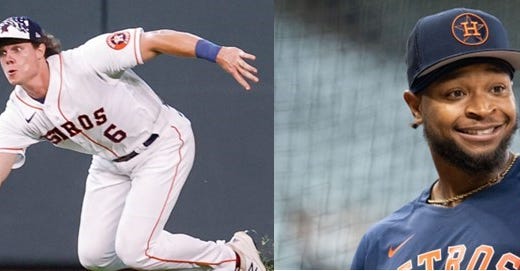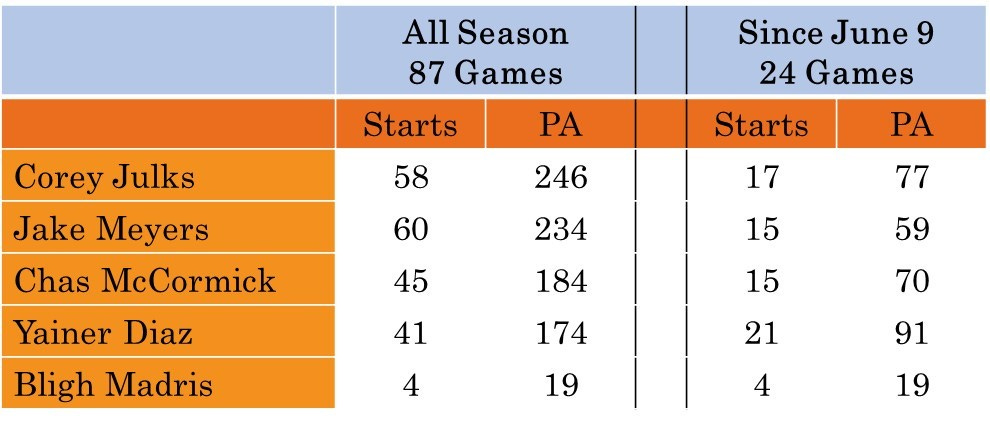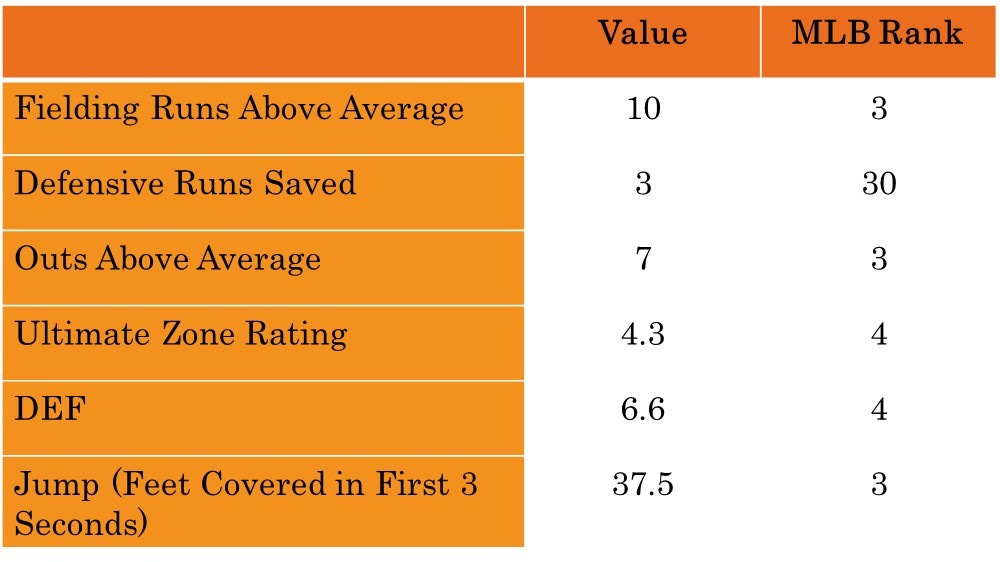The Job Share in the Outfield Is Working Out Better Than Expected
All three of McCormick--via his bat--Meyers--via his glove--and Julks--via improved strike zone judgment--have contributed this year. Do the Astros need to get a bat to replace one of them?
In Arlington, Chas McCormick was the Astros hero. On Sunday, his bases clearing triple in the top of the 8th untied a pitching duel, leading to an 5-3 Astros win. On Monday, his double in the top of the 9th drove in the winning run in a wild 12-11 victory.
Back in Houston, it was Corey Julks’ time to shine. In two games against the Rockies, he went 6 for 8 with a double and walk, helping the Astros to a mini-sweep of Colorado.
Both McCormick and Julks are key parts of the improvement we have seen with the Astros offense in June and July.
And both are part of a three-man job share with Jake Meyers for essentially two positions in the outfield that has worked out better in recent weeks. And the fact that these positions are in better shape than presumed in the off-season raises the question of whether the front office needs to acquire another bat at the trade deadline. At the least, the play of McCormick, Meyers, and Julks this season—and the concerns raised injuries to the rotation and the poor recent form of Cristian Javier—show that acquiring a starting pitcher should be the top priority of the Astros front office.
Let’s review the situation with left field and center field and the three men who occupy it.
An Equal Job Share
Dusty Baker has chosen to have a job share in between McCormick, Meyers, and Julks across two positions—left and center field.
The chart below shows the playing time for these three players. I included Yainer Diaz and Bligh Madris because those two have been in the mix for plate appearances in left field or designated hitter since Yordan Alvarez went on the IL. There are separate columns for playing time across the entire season, and since June 9, the day Alvarez went on the IL.
The chart shows that Dusty has given nearly equal playing time to each of his three left field/center field options. McCormick has received less playing time overall, but that is due to his stint on the injured list early in the season due to back tightness.
Further evidence of the job share is shown in the “Since June 9” columns. Even with more playing time opening up due to Alvarez’s strained oblique, Dusty has maintained nearly equal playing time between Julks, Meyers, and McCormick.
That is not Baker has treated Yainer Diaz, by the way. Baker has made Diaz a nearly everyday player, getting starts in the 21 of he 24 games since Alvarez went on the IL. Diaz has over half of his plate appearances on the season in that 24 game stretch.
The fact that all three of McCormick, Meyers, and Julks bat right handed make for an awkward fit in left and center field. In an ideal world, one would gain a platoon advantage from a left handed batter. But the fact that they are all right handed makes it easier to create equal playing time for all three players.
The fact that there is an equal job share also seems to rankle many Astros fans. Most, as best I can tell, think that Chas McCormick should be an every day player. But the choice of Dusty Baker has been to limit McCormick to the same amount of playing time as both Meyers and Julks.
Chas McCormick, the Offensive Guy
Chas McCormick, never a highly touted prospect, has been a revelation at the plate in the majors. Over 911 major league plate appearances, McCormick has a slash line of .253/.330/.435 with an OPS+ of 112 (12% better than the major league average). And he’s been even better this season, hitting for more power. In 184 plate appearances this season, his triple slash line is .264/.344/.479.
Throughout his career, McCormick has put up excellent defensive numbers in the outfield corners and more modest numbers in center field. But this season, he has put up similar numbers in both positions on a per inning basis. In general, McCormick is better defensively in the corner, but handles himself will in center.
As noted above, most Astros fans I encounter think that McCormick should get the most playing time to the three guys in the job share. And he has the strongest combination of skills of any of these three players. But he remains a guy who plays most days, rather than every day.
Jake Meyers, the Defensive Guy
Who has been a more valuable player to the Astros so far this year? Jake Meyers or Mauricio Dubon? I think it’s the rare Astro fan who wouldn’t say Dubon. But according to Fangraphs’ measure of WAR, the answer is Meyers. As the chart below shows, Meyers ranks 7th on the team in fWAR at 1.5.1
Meyers makes modest contributions at the bat—he has slashed .230/.316/.382 for a 96 wRC+ this season. But the way that Jake Meyers generates such high level of value for the Astros is through his glove.
Jake Meyers is an elite fielder in center field. The chart below shows the defensive numbers for Meyers this season, and the right-hand column shows his rank among Major League outfielders (regardless of position). And in Fielding Runs Above Average, Outs Above Average, Ultimate Zone Rating, and DEF (the metric produced by the fWAR calculation), Meyers is among the four best outfielders in baseball this season.
Why is Jake Meyers such a good defender? The final row in the chart shows a key reason—he gets a great jump on the ball. Statcast can now measure this—defining jump as the distance a player covers in the first three seconds after the ball is hit. Meyers covers on average 37.5 feet in those three seconds. This, like his other defensive numbers, is among the top handful of outfielders in baseball.
Over his career, Jake Meyers has been worth 2.9 fWAR across 554 plate appearances in 168 games. That is essentially a full season’s worth of play at the major league level. That is not the performance of an All Star, but it is the performance of a quality big league regular, an above average performer.
Jake Meyers has struggled at the plate recently, but his glove has great value to the Astros.
Corey Julks, the Improving Guy
Corey Julks was a surprise addition to the Opening Day roster, and it seemed like he would play a bench role while McCormick and Meyers were the every day starters in the outfield until Michael Brantley returned.
But as discussed, Julks has gotten an equal share of the playing time. This surprised me. Julks was not a highly regarded prospect—Fangraphs regarded him as the Astros 18th best prospect entering the season; MLB Pipeline as the 28th. In fact, the Astros exposed Julks to the Rule 5 draft in the Fall, and any team could have claimed him provided they kept him on their 26-man roster all season. Obviously, none did.
And early in the season, my skepticism of Julks was warranted. Over the first two months of the season, Julks could not control the strike zone. He walked in 2.8% of his plate appearances while striking out in 27.2%. He had a productive April, but it was mostly fueled by an unsustainable .383 BABIP (batting average on balls in play). He hit in may like a guy who couldn’t control the strike zone.
But in June, Julks has improved. And that improvement has come primarily by improving his plate discipline. As the graph below shows, Julks’ BB% started rising precipitously around the beginning of June. His K rate has been declining throughout the season, but it begins a sharp downward slope in the middle of June.
The improvement in Julks’ walk and strikeout rates in June are part of a longer term improvement throughout the season in Julks’ swing decisions. As the graph below shows, he has been steadily improving his Contact and Swinging Strike Rates since May.
Since the Alvarez injury, Julks is slashing .333/.429/.424. The batting average is again propped up by a high BABIP (.404), but some of his high batting average is based on improvement in his contact rate.
In general, it looks like Julks has leveled up as a player over the off-season. That level is that of a contributing major league player.
Do They Need to Prioritize a Bat at the Deadline?
Julks is one of three contributing players in the outfield job share for the Astros. Each, as you can see from the team’s fWAR leaderboard in the Meyers section, has contributed basically a win above replacement to the Astros this season. That’s helpful.
And if you have three contributing players at two positions—or at one position when Alvarez returns from the IL—then you may not need to improve those positions. The focus of much speculation among Astros fans about the trade deadline has been the need for a hitter than can play the outfield.
Dana Brown, the Astros GM, has said that he is “focused right now on a bat” and that “a left-handed bat would be exciting,…You could give some guys some time in the outfield, give the first baseman a day, give the DH a day. Having a guy that’s versatile — that would be ideal.”
The effectiveness of McCormick, Meyers, and Julks—in addition to the injuries to Lance McCullers and Luis Garcia and the recent ineffectiveness of Cristian Javier—raises the question if that is the right priority. The need for a rotation arm seems greater right now and moving forward.
It is worth noting that the Astros poorly rated farm system limits their ability to outbid other teams, which limits their ability to make trades at the deadline. In short, they may just get one bit at the apple.
Obviously, one question to ask about the outfield moving forward is can the sustain this level of play. McCormick has shown above average offense throughout his career. He is likely to regress a little in terms of his power, but he should remain an above average hitter. He has been every year of his career.
Similarly, Jake Meyers has shown strong defensive numbers throughout his career. At the plate, Meyers has been up-and-down this season, but his overall numbers look like his career numbers. He can sustain this.
The open question is about Julks, who is in his first season in the majors. Are the improvements he has made in his swing decisions in June part of a larger improvement that will stick, or are they just part of a hot month? It will be necessary for Dana Brown and the front office to find the correct answer to that question. But if the answer is yes, then the Astros can focus on their rotation at the deadline.
Wins Above Replacement calculations are not so precise that the 0.2 point difference between Meyers and Dubon is truly meaningful. But the fact that they are close and that Meyers has the advantage is I think a good demonstration of where Meyers’ value is.










Random question but would you like a BlueSky invite? We need more Astros fans!